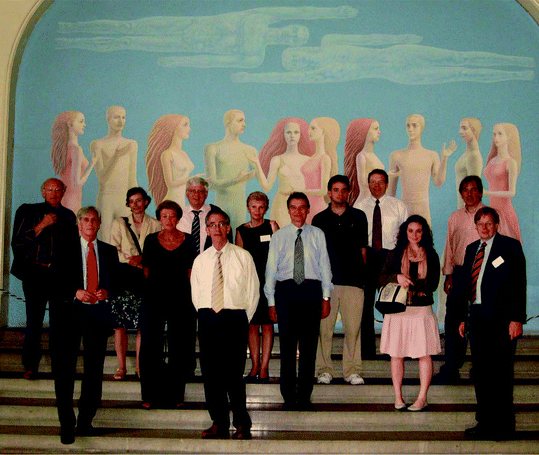Frontiers of Macromolecular and Supramolecular Science symposia
Michael L.
Klein
*a and
Virgil
Percec
 *b
*b
aInstitute of Computational Molecular Science, Temple University, Philadelphia, PA 19122, USA. E-mail: mlklein@temple.edu
bRoy & Diana Vagelos Laboratrories, Department of Chemistry, University of Pennsylvania, Philadelphia, PA 19104-6323, USA. E-mail: Percec@sas.upenn.edu
Abstract
Frontiers of Macromolecular and Supramolecular Science is the name given to a symposium series created in 2008, under the name Frontiers of Macromolecular Science, and continued under the new extended name. This symposium is based only on invited plenary speakers and is held under the auspices of the Romanian Academy of Science, to celebrate the life and achievements of Professor Christofor I. Simionescu, who was Director of the Petru Poni Institute of Macromolecular Chemistry in Iasi, Romania, for 30 years (1970–2000). During this time, Simionescu promoted intense research activity and advanced the field of organic and macromolecular chemistry over several domains including the chemistry of wood, cellulose materials and polysaccharides, the synthesis of new initiators, new monomers and polymerizations, mechano-chemistry of polymers, plasma-chemistry and origins of life, electro-initiated polymerizations, and macromolecular charge-transfer complexes (CTC). He developed the chemistry for the synthesis of acetylenic macromolecular compounds and derivatives with photoconductive properties, and elaborated the conduction theory in organic compounds. As the name of the series implies, the symposia have featured, from the outset, frontier science. Importantly, participating plenary speakers have included the leaders of macromolecular science from the USA, Europe, and Asia. The symposia, which are typically held in the Romanian Academy in Bucharest, as well as in the Romanian Academy's Petru Poni Institute in Iasi, provide a fitting and continuing tribute to Professor Christofor I. Simionescu, the founding father of Macromolecular Science in Romania.
Christofor I. Simionescu – a man ahead of his time
Christofor I. Simionescu was born on July 17, 1920 and passed away on August 6, 2007. His scientific biography is extraordinary. Highpoints of his career include being promoted to Full Professor, and the Chair of Natural and Synthetic Macromolecules, when he was only 32 years old and election to the Romania Academy at 43 years of age. He served as a Vice President of the Romania Academy for many years – specifically from 1974 to 1990 and was its acting President from 1977 to 1980. Siminonescu's entire career was spent in Iasi, where for many years he held positions at the Gheoghe Asachi Technical University, as well as in the Romanian Academy's Petru Poni Institute. Notably, the name of the Petru Poni Institute was changed under his urging from the Institute of Chemistry to the Institute of Macromolecular Chemistry in 1964; an action that positioned the Institute at the forefront of the new field. Astonishingly, Simionescu was director of the Petru Poni Institute for Macromolecular Chemistry from 1970 until he was eighty years old in 2000.On the occasion of his 70th birthday, Negulescu and Vogel published an article summarizing the accomplishments, honors, and awards, associated with Simionescu's illustrious career.1 Above all, they pointed to the obvious fact that “as an educator, colleague, and scientist, Cristofor Simionescu is an example of perseverance and tenacity”. Simionescu not only created a stimulating atmosphere both at the University and at the Institute of Macromolecular Chemistry but also produced talented students that now work across Romania and around the world. Simionescu's devotion to both teaching and research, which he successfully combined throughout his career, was one the most enduring characteristic features of his multifaceted career.
On the occasion of Cristofor Simionescu's 75th birthday in 1995, an International Conference was organized by Virgil Percec at the Romanian Academy in Iasi to honor his mentor. The meeting attracted many of the leading researchers in the field of Macromolecular Chemistry, including Dave Tirrell, Bruce Novak, Krzysztof Matyjaszewski, Coleen Pugh, and Virgil Percec from the USA, as well as, Klaus Muellen, Jos Put, and Bert Meijer from Europe, plus Mitsuo Sawamoto, and Shiro Kobayashi from Japan, along with local participants, Bogdan Simionescu and Virgil Barboiu, plus many others. This impressive array of talent was a testament to the high esteem to which his colleagues held Christofor Simionescu (Fig. 1).
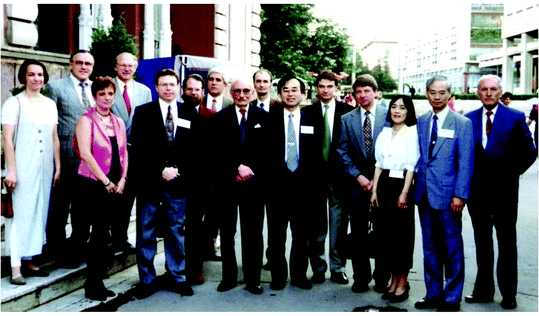 | ||
| Fig. 1 Participants of the 1995 Iasi symposium celebrating the 75th birthday of Christofor I. Simionescu. | ||
Also, in 1995, Virgil Percec edited an issue of the Journal of Macromolecular Science, which was dedicated to the 75th birthday of Cristofor Simionescu;2 contributors included: Virgil Barboiu, Valeria Harabagiu, Simona Percec, Mihai Dimonie, Bogdan Simionescu, Patrick Cassidy, Otto Vogel, Dorel Feldman, Hans A. Schneider, Hans-Joachim Cantow, and Virgil Percec. Highlights of his activities up to his 60th birthday were also published.3,4
The first Christofor I. Simionescu symposium: June 19–20, 2008
The phenomenal and far-reaching influence of Cristofor I. Simionescu at both the Gheoghe Asachi Technical University and the Romanian Academy's Petru Poni Institute in Iasi is legendary. His achievements are all the more astonishing given the very challenging times in post World War II Romania. However, Cristofor I. Simionescu was much more than a visionary researcher who impacted broadly the fields of Organic and Macromolecular Chemistry through his publications and voluminous writings. Importantly, he was an efficient administrator, brilliant teacher, and spectacular mentor, whose ability to juggle multiple jobs and responsibilities was awe-inspiring. As already mentioned, Simionescu was elected to the Romanian Academy at a very young age and served as a Vice President and Chief of the Academy's Iasi branch for many years. Notably, at the Gheoghe Asachi Technical University in Iasi, he was Professor and Head of Department for decades, as well as being the Rector for more than 20 years. At the Romania Academy's Petru Poni Institute, he was initially the Chief of Macromolecular Chemistry, before being appointed Director of the Institute, a position he held for three decades.On hearing the sad news of Simionescu's passing in August 2007, Virgil Percec was inspired to do something significant to honor his mentor's extraordinary accomplishments. To this end, he hatched a plan to create a series of high-level scientific meetings entitled: Frontiers in Macromolecular and Supramolecular Science, which would become a permanent tribute. Notably, the first Cristofor I. Simionescu (CIS) symposium came to fruition, in much less than one year, with enthusiastic support from many at the Petru Poni Institute in Iasi, especially Bogdan Simionescu and Virgil Barboiu. The first CIS symposium, which featured several of the speakers from the 75th birthday celebration in 1995, was a resounding success (Fig. 2).
Under Virgil Percec's stewardship, the second and third CIS symposia were held in 2009 and 2010, respectively; this time in two locations to maximize the impact of the distinguished speakers. The first session was held at the Romania Academy in Bucharest, and the second session at the Academy's Petru Poni Institute in Iasi. Given that the symposia were organized in two parts, the organizers (Bogdan Simionescu and Valeria Harabagiu) arranged for the speakers to experience cultural aspects of Romania, including World-Heritage-designated monasteries, museums, and the beautiful countryside.
The fourth CIS symposium in 2011 also followed a similar format with sessions in both Bucharest and Iasi. This time the participants included: Mihai Barboiu, David M. Haddleton, Ionel Haiduc, Michael L. Klein, Bert Meijer, Raffaele Mazzenga, Martin Moller, Roeland Nolte, Virgil Percec, Hans-Werner Schmidt, Cristian Silvestru, and Sir J. Fraser Stoddart (Fig. 3). The highlight of the cultural activities was a visit to Dracula's Castle (Fig. 4).
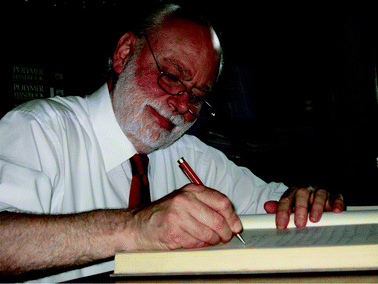 | ||
| Fig. 3 Sir J. Fraser Stoddart signing the visitors book in June 2011 at the Petru Poni Institute of the Romanian Academy in Iasi on the occasion of the fourth CIS symposium. | ||
The fifth CIS symposium was held only in the Romania Academy in Bucharest in 2012 and featured lectures spanning three days. Speakers included: Takuzo Aida, Frank Bates, Martin Moller, Jean Francois Nierengarten, Virgil Percec, Boris Rybtchinski, Mitsuo Sawamoto, Ulrich Schubert, Doran Shabbat and Tim Swager.
The sixth (2013) CIS symposium saw a return to the two-location format and featured the following lecturers: Joanna Aizenberg, Michael Aizenberg, David Haddleton, David Milstein, Martin Moller, Eiichi Nakamura, Virgil Percec, Peter Seeberger and Frank Wuerthner.
The seventh (2015), eighth (2016) and ninth (2017) CIS symposia also employed a two-location format.
Speakers at the eighth symposium included: Joanna Aizenberg, Jean Frechet, Peter Seeberger, Virgil Percec, Beate Koksch, and Nobel Laureate Robert Grubbs (Fig. 5 and 6).
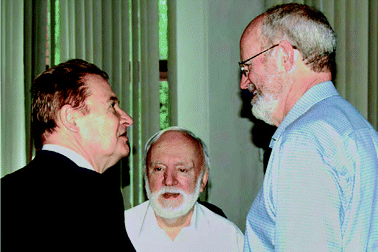 | ||
| Fig. 5 Intense discussion followed the lecture by Nobel Laureate Robert H. Grubbs at the Petru Poni Institute in Iasi on the occasion of the eighth CIS symposium held in June 2016. | ||
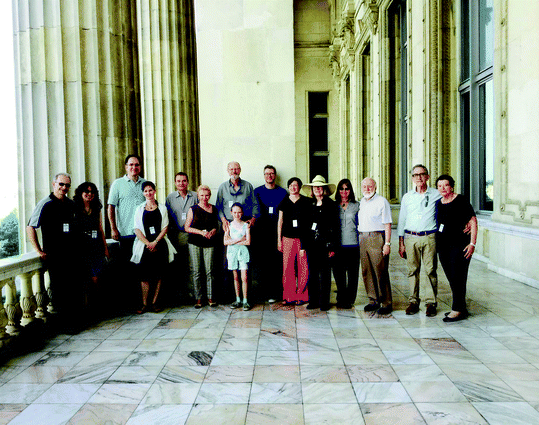 | ||
| Fig. 6 Eighth CIS symposium participants on a visit to the Palace of the People in Bucharest, June 2016. | ||
Closing remarks
At the time of writing, there have been eight CIS symposia, at which all of the speakers have been truly outstanding, including Nobel Laureates Robert H. Grubbs and Sir J. Fraser Stoddart. The eighth CIS symposium was also dedicated to the 150th Anniversary of the Romanian Academy, which was founded only three years after President Abraham Lincoln created the US National Academy of Sciences, in 1863.In 2020, we will surely celebrate the centennial of Cristofor I. Simionescu's birth. In everyday life, 20/20 is synonymous with visual acuity. It is all the more fitting that the year 2020 should be reserved for a celebration of Cristofor I. Simionescu, whose clarity of vision for the field he helped create is already legendary.
This special collection in Polymer Chemistry contains a selection of publications contributed by lecturers at these symposia and friends of Cristofor I. Simionescu.
Acknowledgements
Financial support from the National Science Foundation (Grants DMR-1066116 and DMR-1120901), the P. Roy Vagelos Chair at the University of Pennsylvania, the Humboldt Foundation (all to V. P.), and National Science Foundation (Grant DMR-1120901 to M. L. K.) is greatly acknowledged.References
- I. I. Negulescu and O. Vogel, Professor Cristofor I. Simionescu on His 70th Birthday, J. Macromol. Sci., Chem., 1991, 28, 597–600, DOI:10.1080/00222339108052110; Professor Cristofor I. Simionescu on his 70th Birthday, ed. I. I. Negulescu, Marcel Dekker, Inc., New York, 1990, vol. 28 Search PubMed.
- A special issue in honor of Professor Cristofor I. Simionescu on the occasion of his 75th birthday V. Percec, J. Macromol. Sci., Pure Appl. Chem., 1995, 32, 1381–1383 CrossRef; A special issue in honor of Professor Cristofor I. Simionescu on the occasion of his 75th birthday, ed. V. Percec, Marcel Dekker Inc., New York, 1995, vol. 32 Search PubMed.
- The editors, Professor Cristofor I. Simionescu at His 60th, Polym. Bull., 1980, 2, 497–498 Search PubMed.
- N. Asandei, Professor Cristofor I. Simionescu 60 years, Acta Polym., 1980, 31, 466 CrossRef.
| This journal is © The Royal Society of Chemistry 2018 |

